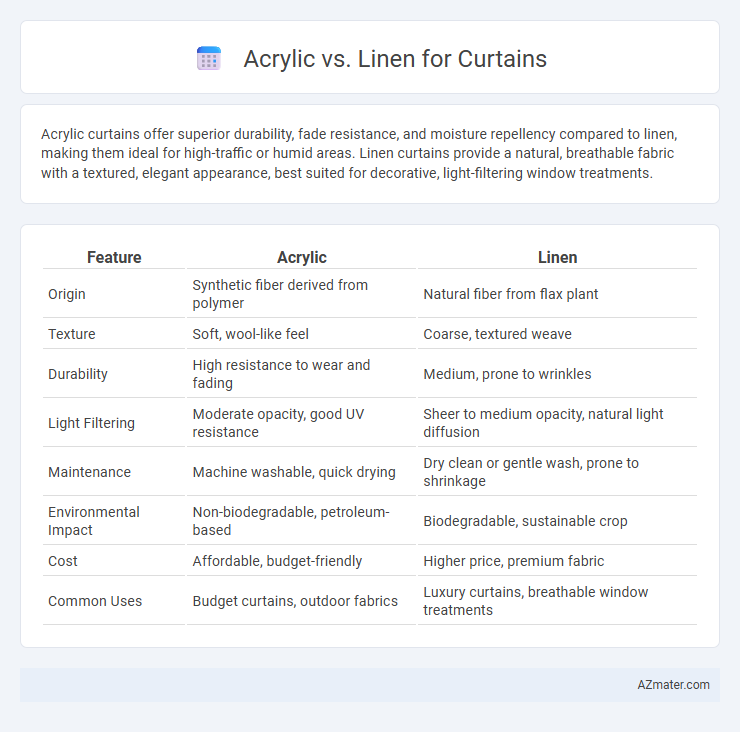Acrylic curtains offer superior durability, fade resistance, and moisture repellency compared to linen, making them ideal for high-traffic or humid areas. Linen curtains provide a natural, breathable fabric with a textured, elegant appearance, best suited for decorative, light-filtering window treatments.
Table of Comparison
| Feature | Acrylic | Linen |
|---|---|---|
| Origin | Synthetic fiber derived from polymer | Natural fiber from flax plant |
| Texture | Soft, wool-like feel | Coarse, textured weave |
| Durability | High resistance to wear and fading | Medium, prone to wrinkles |
| Light Filtering | Moderate opacity, good UV resistance | Sheer to medium opacity, natural light diffusion |
| Maintenance | Machine washable, quick drying | Dry clean or gentle wash, prone to shrinkage |
| Environmental Impact | Non-biodegradable, petroleum-based | Biodegradable, sustainable crop |
| Cost | Affordable, budget-friendly | Higher price, premium fabric |
| Common Uses | Budget curtains, outdoor fabrics | Luxury curtains, breathable window treatments |
Overview of Acrylic and Linen Curtains
Acrylic curtains offer excellent durability, colorfastness, and resistance to moisture, making them ideal for areas prone to humidity or direct sunlight. Linen curtains provide a natural, breathable fabric with a textured appearance, adding an elegant, lightweight feel to any room while promoting airflow. Both materials vary in maintenance requirements, with acrylic being low-maintenance and linen needing gentle care to prevent wrinkles and wear.
Material Composition and Characteristics
Acrylic curtains consist of synthetic fibers known for their durability, resistance to fading, and ease of maintenance, making them ideal for high-humidity or sun-exposed areas. Linen curtains are made from natural flax fibers, offering breathability, a textured appearance, and a luxurious, organic feel while being more prone to wrinkling and requiring gentle care. The choice between acrylic and linen depends on balancing synthetic durability with natural aesthetic appeal and maintenance preferences.
Durability and Longevity Comparison
Acrylic curtains offer superior durability due to their resistance to fading, moisture, and mildew, making them ideal for high-humidity environments or frequent sun exposure. Linen curtains, while providing a natural, breathable fabric, tend to wear faster and may develop wrinkles or discoloration over time. For longevity, acrylic maintains its appearance and structural integrity longer than linen, which requires more delicate care to preserve its lifespan.
Light Filtration and Privacy
Acrylic curtains offer moderate light filtration with a smooth texture that gently diffuses sunlight while maintaining privacy, making them suitable for rooms requiring balanced illumination. Linen curtains allow more natural light to pass through due to their loose weave, creating an airy atmosphere but providing less privacy compared to acrylic. For enhanced privacy without sacrificing light, acrylic fabrics are preferable in living rooms or bedrooms where controlled brightness is essential.
Texture, Appearance, and Aesthetics
Acrylic curtains offer a smooth, lightweight texture with a soft sheen that closely mimics natural fibers, making them resistant to fading and easy to maintain. Linen curtains feature a coarser, natural weave with visible slubs, providing a crisp, organic appearance that enhances rustic and modern decor styles. Acrylic's consistent texture and vibrant color retention contrast with linen's breathable, textured fabric that ages beautifully, adding character to any space.
Maintenance and Cleaning Requirements
Acrylic curtains are known for their low maintenance, requiring only regular dusting and occasional gentle washing to maintain their color and texture, making them ideal for busy households. Linen curtains, while offering a natural and breathable fabric choice, demand more careful cleaning methods such as dry cleaning or gentle hand washing to prevent shrinking and fabric damage. Acrylic resists mildew and fading better than linen, which may need more frequent cleaning due to its absorbent nature.
Energy Efficiency and Insulation
Acrylic curtains provide excellent energy efficiency due to their dense weave and ability to repel moisture, which helps maintain indoor temperature by reducing heat loss and blocking cold drafts. Linen curtains, while offering natural breathability and aesthetic appeal, have a looser weave that provides less effective insulation against heat transfer compared to acrylic. Choosing acrylic curtains enhances thermal insulation and energy savings by minimizing the need for excessive heating or cooling in living spaces.
Cost Comparison: Acrylic vs Linen Curtains
Acrylic curtains typically cost less than linen curtains, making them a budget-friendly option for homeowners seeking affordability without sacrificing style. Linen curtains, known for their natural texture and durability, generally come at a higher price point due to the quality of the fabric and its eco-friendly production process. When comparing cost, acrylic offers a more economical choice, but linen provides long-term value with its premium feel and longevity.
Environmental Impact and Sustainability
Acrylic curtains are made from synthetic polymers derived from petrochemicals, resulting in higher carbon emissions and limited biodegradability compared to linen. Linen curtains, sourced from flax plants, offer a more sustainable choice due to their renewable cultivation, lower water usage, and natural biodegradability. Choosing linen helps reduce environmental impact through eco-friendly farming practices and minimal chemical processing.
Choosing the Best Option for Your Home
Acrylic curtains offer durability, resistance to fading, and easy maintenance, making them ideal for homes with high sunlight exposure or frequent cleaning needs. Linen curtains provide a natural, breathable fabric with a textured appearance that enhances elegance and allows gentle light diffusion, perfect for creating a cozy and airy ambiance. Selecting between acrylic and linen depends on your priorities for durability versus natural aesthetics and how you want to balance functionality with style in your living space.

Infographic: Acrylic vs Linen for Curtain
 azmater.com
azmater.com